Episode #370: Why Most District Math Improvement Plans Fail (And How to Fix It)
LISTEN NOW HERE…
WATCH NOW…
District improvement efforts often stall—not because of a lack of intention, but because of misaligned objectives, vague goals, or a failure to track meaningful progress. In this episode, we dig into the foundational question: What are we really trying to achieve? You’ll learn how to craft clear, lofty district-wide objectives that serve as a true north year over year, while also committing to short-term key results that are specific, time-bound, and attainable. Most importantly, we discuss how to build the monitoring systems that ensure your actions translate to outcomes. Whether you’re a district leader, school administrator, or instructional coach, this episode offers a roadmap to drive intentional, measurable change in your system.
In this episode, you’ll discover:
- Why yearly goal-setting often leads to misalignment and fatigue
- The difference between transformational objectives and key results
- How to define 3-, 6-, and 9-month milestones that are realistic and measurable
- Questions to ask when committing to an action: Is it clear? Is it possible? Is it worth it?
- How to use progress monitoring systems to keep a pulse on change
Attention District Math Leaders:
Not sure what matters most when designing math improvement plans? Take this assessment and get a free customized report: https://makemathmoments.com/grow/
Ready to design your math improvement plan with guidance, support and using structure? Learn how to follow our 4 stage process. https://growyourmathprogram.com
Looking to supplement your curriculum with problem based lessons and units? Make Math Moments Problem Based Lessons & Units
Be Our Next Podcast Guest!
Join as an Interview Guest or on a Mentoring Moment Call
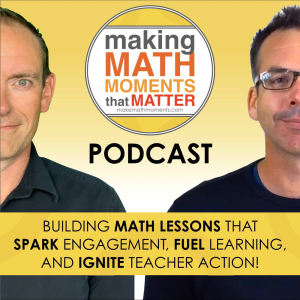
Apply to be a Featured Interview Guest
Book a Mentoring Moment Coaching Call
Are You an Official Math Moment Maker?
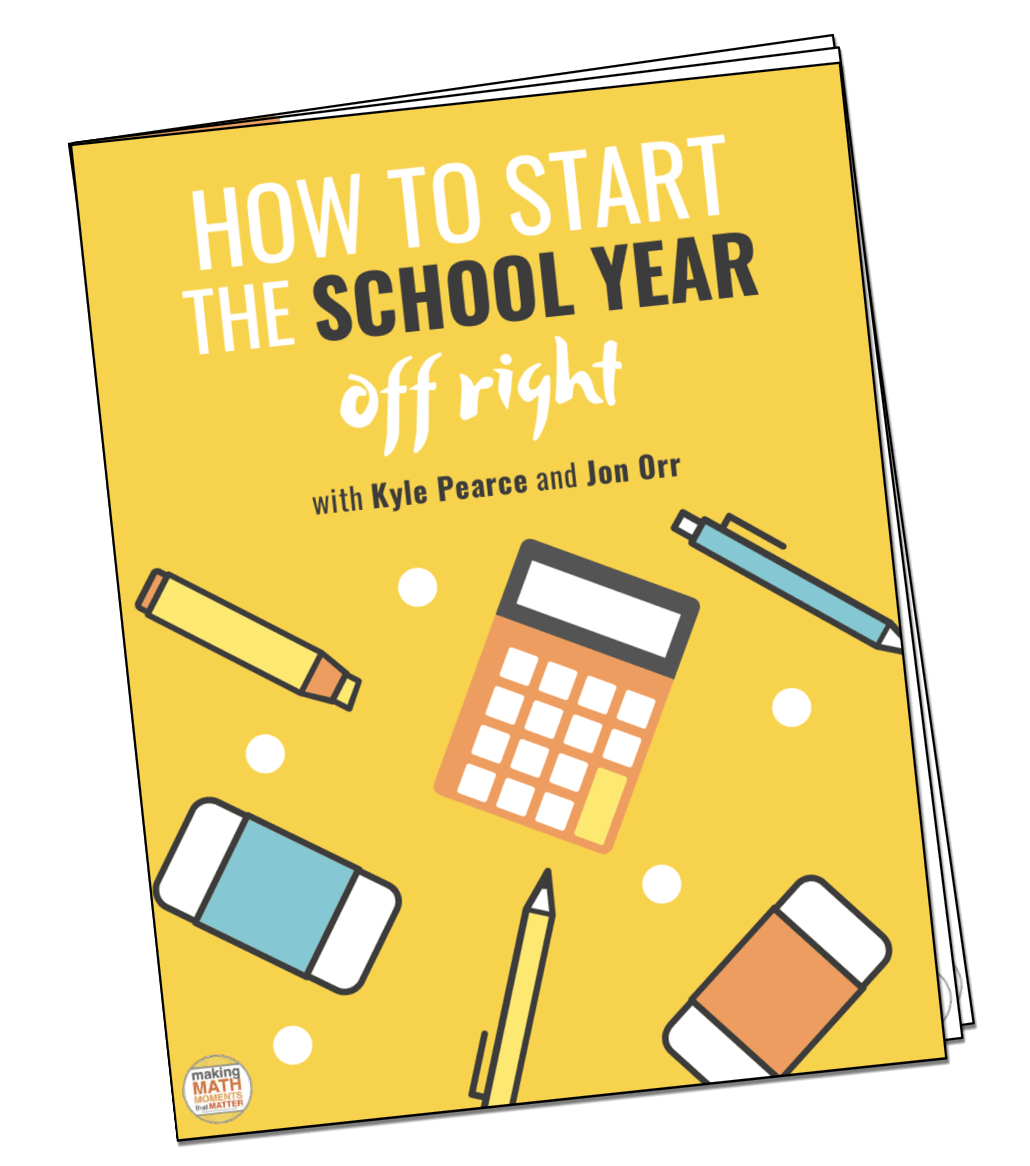
FULL TRANSCRIPT
Jon Orr: In this episode, we’re going to look at how to structure the goals that you’re setting for your math improvement plans at your school level or at the district level. And specifically, we’re going to outline the process we use when we work with our district partners, our school level partners, when we support them in designing sustainable and actionable math improvement plans for growth.
And part of that process lies in stage one. Stage one for our process is design and measure, which is making sure that we’re measuring the right things and setting appropriate goals, which we call objectives and key results. So it’s coming from the book by John Doar, which was Measure the Matters. He uses an OKR process. He’s helped many organizations grow and hit goals and show improvement and growth.
This is the part of the process that we use when we partner with districts to help them set goals and the right measures to monitor progress that helps them indicate their success and their achievements on their improvement goals for math professional development and teachers growth and teaching students achievement. And part of that process is looking at what an objective is and what a key result is. And today we want to kind of unpack
how to say set an objective, but really how to measure an objective, which is a long-term goal, and then also how to create, say, the right measure for a key result, which is, say, a short-term goal. And what is the difference between those two, and why does the difference actually matter? So Yvette, why don’t we dive right in here and maybe unpack a little bit about, say, what objectives really are?
Yvette Lehman: So the way that we define objectives, are, I like when you use the word John focus zones. It’s like areas in mathematics teaching and learning that we want to strengthen. And oftentimes we describe them in terms of the outcomes that we want for students because that’s really the why behind the work that we do. If it doesn’t transfer to the student experience or student outcomes, then it’s probably not the right work.
So we like to say that objectives are long-term changes we want to see in student behavior, student experiences, student outcomes. So I’m gonna, for the purpose of breaking this down, we’re gonna use an example and maybe we’ll carry that example throughout the entire conversation. So imagine that long-term, the change you want to see is that you wanna walk into classrooms and you wanna see students using a variety of models and strategies. So you shouldn’t just walk in and see everybody in the room mimicking the same
long division algorithm, but you see them solving a problem that involves division and you see a variety of approaches. it’s like students are flexibly making connections between a variety of strategies and they’re using models as tools for thinking. That’s the change you want to see long term. But that change is probably not something you’re going to measure in a month, two months, six months. It’s going to be a gradual
gradual transformative change over time as a result of the actions that you take as a district to strengthen that area. And so when it comes to that, we could be working on that objective. Ideally, you know, three to five years, it’s not something that’s going to, you know, it’s going to be a one year and done and we move on from it. To really see that true transformation, it’s going to happen over time. And so that’s something that we would call an objective.
Jon Orr: Yeah, and ideally it’s something like you’re saying is like that you wouldn’t want to make changes on in a one year, two year, three year time period. want, like you can say, like I’m gonna want for a long time to be working on making sure that we’re seeing models and strategies as a regular walk. know, when we walk into classrooms, that’s a regular part of what we see in terms of the vision for mathematics across the system that we’re working with. So objectives.
are long term, but also you like, you don’t want to change them. And partly why you don’t want to change those focuses is to help make sure that we’re having consistency across the focuses that we’re strengthening with the people that we’re working with, teachers, administrators, support staff of saying like, we’re always working on this, and we’re always working on maybe one other one. And those form the basis for what we’re working on so that we’re not constantly saying, we got a new initiative, we got a new initiative, we got a new initiative. So that’s the way that we look at objectives and with, they’re really those long-term goals.
Yvette Lehman: think too, you mentioned the word consistency and it’s like we’re working toward that being a norm in every classroom or a high percentage of classrooms. So it’s not only in our bright spots that we’re seeing the consistent use of a variety of models and strategies. That’s just the way we do business in our district. That is an expectation or a norm across all classrooms. And we know that to support implementation across classrooms with consistency, to create that horizontal and vertical alignment is going to take time.
Kyle Pearce: Now, I’m wondering, this process is one of these scenarios, one of these situations where a lot of the districts we’re working with are struggling with, right? Trying to identify what is actually an objective and maybe what is not, or maybe what is not an ideal objective. And I don’t want to say that we’ve got, you know,
the 12 magic objectives over here on the wall. And, you know, we’re, just going to hand that off to a district, but ultimately it can be very, very messy when we’re doing this work. And it can be very, very challenging for, for district leaders, school leaders to try to hone in on an objective that is not only worthwhile for the long-term. I like how you mentioned that, John, like this isn’t something that we’re just going to do for a couple of months or
one school year and then we’re just going to kind of move on from it and never talk about it again. This should be something that we actually want to be at a we’ll say the foundation of our math programming. And we want to see this happening and growing for a number of years, not to mention that it’s not going to be something that can change overnight. So give us some examples like where what are some common maybe objectives or I’m going to use bunny ears and say things that oftentimes we get thinking that could be an objective but maybe aren’t so helpful in the process.
Jon Orr: Yeah. I think that nailed it is that the objective needs to be about what that student experience is going to change into. So an objective is a change that’s going to occur over the long term. So it’s not something you’re currently doing. It’s not an action item. It’s also not, say, resource specific. So you’re not saying, hey, we’re going to be focused on implementing blank tool in our classrooms. And that’s the.
what we’re going to do. And I think when we when we analyze and audit school improvement plans or district improvement plans that you know, we see that a lot. We see that there’s a hey, the goal here is to be able to to say implement blank, you know, and it’s usually a resource. And that’s, and I think even though that might be one of the channels or methods or structures you want to use as a vehicle, you have to then ask yourself the the so what question.
or the, you know, we’ve often said here, like, I think Blaine McIntosh said, was like, ask yourself why five times, it’s like, well, what is the why behind that resource being important? That’s the objective that you’re actually looking to create change onto, right? So it’s, and make sure it’s student and student experience. So, so like, we’re not making, we’re not fully, our goal here is to implement BTC across the system. That’s the vehicle that might help you get to the why behind that. And so you just want to clearly define what is the, what is that?
Get us, like what do we try to do, use that for? And that can be the focus of the work that you’re gonna do.
Kyle Pearce: Well, an example that comes to mind, and it’s one that I think a lot of schools and districts are utilizing even to this day, they get in the habit of looking at, a measure. Like, we want, you know, my objective is to see 10 % of students do blank, right? Or that, you know, our grade, our overall standardized test scores will rise by 10%. And that’s not really an objective, right? Because what do we really want? It’s not the grade.
It’s what’s under the grade and what are the things that we’re gonna have to do in order to get us to a place where maybe we’ll see some of those grades or those scores starting to shift over time because we did the real work underneath the hood that helped position students to do and perform better in mathematics in general.
Jon Orr: Well, that’s a great segue into the measurements, right? Because I think where even if you did define, say, an objective or what we think is an appropriate objective for long-term growth, many districts will then say the measure of that objective, and I think you’re saying, as a lot of times people say, the goal, which is just student improvement on standardized test results, is even if they did say, here’s an appropriate objective, how we’ll measure
that that objective came true is we’ll go look at the standardized test results. We’ll go look at how our students did this year. And we use that to decide whether the actions we use this year or did this year, or maybe it is the long term, are in the right way, know, they’re changing in the right ways, which there’s problems there, right? There’s gaps there. There’s cloudiness there to say like, are the things that we did this year, are the action items that we did this year actually
Do we have a causation or correlation to say that that actually changed the student results? Or can we attribute to those results? Or is it too cloudy? And so what we would recommend is to not use standardized test results as your measure of how your, system is doing on your objectives. They are there to look at as, say, trending data to go, like, are we generally going in the right way? Because those those valid methods to look at. But they’re not.
they shouldn’t be used to look at as to decide are the actions that we’re doing on the professional development side working or not working. And because what happens is when you look at those standardized test results and you can’t attribute to the work that you did this year or over the last two years, even over the last three years for the long term to that standardized test, then you’re often left going, well, let’s try something new. And when we start trying something new again, we’re still going back to the land of like,
initiative new and then another initiative, another initiative. Like so, so avoiding that and the consistency says measure the change you want to see. And oftentimes it involves you measuring or creating a tool that you can use to measure the actual changes around the things that you want to see. Right, Yvette? Like what would you say, like what would be an example of a measurement that we would say as a, as a long-term measurement of the objective?
Yvette Lehman: So we described that objective of using multiple models and strategies for problem solving. So just as one example, it’s not the only example of course, but maybe it is a strategic walkthrough protocol where we’re scheduling visits to let’s say 25 % of classrooms and we’re documenting the frequency of a variety of strategies and models. And that doesn’t have to happen.
every six months, even every year. Like I would probably start by collecting my baseline data, graphing the frequency of the use of models, the use of strategies separately. And then maybe when we feel like there’s been enough work around that objective, we wanna take a pulse and we’re looking for gradual shift and change across the system over time. And so the next time we go through, maybe 14 months later,
we see that there were more models, more strategies than the first walkthrough. And then we come back another year later and again, we see an increase in the frequency and that’s our ability to keep a pulse on the work towards our objective. And if we get to a point where we are routinely walking into random sampling 25 % of classrooms during their math block and it is common.
practice to observe students using a variety of models, a variety of strategies, that’s an indicator that we’ve achieved our objective and it’s time to move on.
Kyle Pearce: And you know, and I want to pause there because you know, in a perfect world, that would be by the end of a school year, right? But the reality is, is that it’s not going to happen in one school year because you know, the interesting pieces is that you might go through and do some monitoring and you might not see much change at all. And then you have to start asking the real questions in a perfect world. Everything’s progressing nicely and you just carry on. But the reality is,
is I’m going to guess that things aren’t going to change at first. And then it forces you to start thinking about what are the actual next steps that we need to take in order to figure out why is that? Is it teacher content knowledge, where they’re struggling because they don’t know the strategies and models that could be helpful or appropriate? Is it that the resource that we have isn’t conducive? We have to now do more and more digging.
just to try to figure out where the bottleneck is in us trying to get closer to actually reaching success with that particular objective.
Jon Orr: Well, what you’re identifying is why say, the four stages that we use is is a flywheel effect in our cyclical, a cyclical process is because we want it to be, you know, year to year and continue to ask our questions like you’re asking, like, are we on track to achieving this objective? Are the things that we did this year, you know, are we collecting evidence on the things that we did to actually give us the indicator that these things are going to say result in that
long term measure changing. Because, because you don’t want to get to the end of the year and go, I don’t I don’t know, you know, and because that’s, that’s where that’s, that’s where that’s like, we start, we scrap things, and we start all over again. And we do the spaghetti at the wall approach, where we keep just tossing things at the problem. But you ask yourselves the good questions, like you just asked, like, what, I’m not going to switch the objective, because the things we did this year may not have worked the way we thought it what what is the
what is the barrier, the bottleneck, pebble that’s rattling around on our shoes right now that’s preventing us from seeing success on say that really important long-term objective and then developing say appropriate key results or small short-term goals that can help you achieve those long-term results. So that’s again, Kyle, hey, nice segue into like what a key result is and how do we actually structure the measure for a key result. Yvette, back to you. Yeah.
Yvette Lehman: I’m excited about this. Okay, so imagine this is the goal. That’s the long term change we want to see. Now the question is, what is the immediate work right now in the next three months, six months, nine months? What are we going to do as a district? What are we going to commit to, to help us get closer to that goal? And that is our key result. And you may have one key result, two key results, three key results, depending on the capacity.
of your team and the available channels. So here’s an example of a key result. I might say that by the end of the year, by June 2026, 100 % of grade one to six teachers will implement a problem string at least once a week.
Jon Orr: 100%.
Yvette Lehman: 100%. That
Kyle Pearce: Well, you know, I thought as soon as you said 100%, I was going, boy, she’s getting very bold. But you did say though, at least once a week, which is not a really unrealistic thing to ask, right? Or to expect.
Jon Orr: Well, I’m like, geez, she’s she’s getting.
Yvette Lehman: Right and grade one to six.
Jon Orr: Well, here, well, I wanna talk about that. Yeah, you’re being specific. So I wanna talk about what you just said there, Kyle, but before we do, I think just to point out the key result here is Ivette is saying it’s timely, right? So we’re putting a date on it. We are specific. And then here’s the other part, right? So here’s the part that Kyle was kind of hinting at or wondering about, because when we say 100%, we actually, to make a key result, in a way, and I’ll be honest here.
for the districts that we support, we supported over the years to create key results, to create objectives, to create math improvement plans that support those. This is the hardest part because we have to get real about what will be likely to occur to achieve that key result, which means can I commit to, yeah, good word, can I commit to what is necessary to achieve that key result?
So if I say I want my key result to be 100 % of my teachers to implement in the grades 1 to 6, can I commit to the necessary support across my learning subsystems, my large-scale pull-outs, my PLCs, my 101 coaching? Can we coordinate an effort to make that happen, knowing that it takes repeated touch points with individual teachers to see change in practice?
So 100%, it might be true if you’ve got two schools you’re working with and you have, say, some coaches who are dedicated to this process, but it might not be the right key result for you if you can’t commit to, say, touching every teacher multiple times throughout that one year to achieve 100 % status. You might say, it’s a 10 % goal because I can only work with five teachers this year and I have blank amount of teachers.
So that’s the hard part about a key result is also going like you have to pair the measure of your key result to the support that you can dedicate to achieving it, which means you just have to decide on what your expectation is and match it with reality.
Yvette Lehman: when it comes to a key result, really like to use the if then how structure to rationalize like why this makes sense. So here I’m going to make that statement. So if teachers implement fluency routines or problem strings routinely, then what’s the impact going to be? know, teachers and
students are going to be more familiar with a variety of models if they’re implementing a high quality instructional resource. The last question is really important. How will we know we have 100 %? And so some considerations for how in this model that I’m designing, you know, hypothetically on this call right now, we do have coaching support for all teachers in grade one to six.
And so there’s coaching logs happening where coaches are actually going in and observing the problem strings with the teachers that they’re aligned to. And we can also look at weekly daybooks or lesson plans to ensure that there is fidelity of this particular instructional approach. And so that’s really an important question for whoever’s designing this professional development plan is we have to understand why this move. Like what does research tell us about the impact of this move?
Research suggests that the implementation of fluency routines in particular problem strings that are strategies based are a great way to build capacity for educators. So we need to also put in their hands a high quality instructional material. The other question that I asked too is like if the goal is 100 % and maybe, know, in your district, that’s not a realistic goal. As John said, maybe 10 % is a more realistic goal, but how will you know it’s actually happening consistently? When you get to the end of the year,
How can you put a check mark next to this key result? What evidence have you gathered to suggest that you have actually achieved this key result?
Kyle Pearce: Right, right. I think this is really helpful, you know, when it goes back to what is a helpful objective. And now we’re looking at, you know, again, how we can actually pave a path to get closer. And I’m very cautious in the language I use here, because again, it’s all about getting closer. It’s not necessarily about everything being done and being done perfectly. It’s about setting those realistic, timely, attainable, measurable.
relevant goals, right? And going, if we do it, and we do it in this way, I should be able to realistically expect to get to blank place, right? And and I like how you said you have 100 % well in that 100 % scenario of grade one to six teachers, there better be enough support to help those teachers so that I can put 100 % there confidently because if it’s only through an email blast that says thou shalt
throughout the rest of this year, implement a number string at least once a week. Even if I went into classrooms and we saw that this was actually happening, my question would then be is how high quality was the delivery of that work? And then you also have to ask yourself, did that actually help or actually hurt the actual getting closer to the objective? Because if you do something and everyone’s doing it, but they’re doing it poorly and they don’t have the right support.
They don’t have the right resources in place. You could actually move backwards and you might start questioning whether my objective was even the right objective in the first place. And it could all be due to just simply a lack of support or a over, we’ll, say over ambitious goal setting without having realistic plans to support along the way.
Yvette Lehman: And that goes to the connection to, okay, we have our objective, which is this loftier, transformative change we wanna see happen over time.
And we’re keeping a pulse on that change over time, larger intervals in between. Then we have to make decisions about our immediate moves. So what immediate changes do we want to see happen in the next three months, six months, nine months, 12 months to help us get closer to that goal? If we believe in this case, for example, we use the example of problem strings. If we believe that that is a move that’s going to help us get closer to our goal, then we need to commit to it a hundred percent.
which means we need to, grades one to six, we need to look at all of our touch points and all of our available channels to support them. We need to engage our leadership in understanding the why. We need to look at the adoption model and work through the stages of the adoption model, which is understanding the why, seeing it in action, believing that I’m capable of doing it, having the confidence, belief that my students are capable of doing it, and ongoing support. And if we can’t, offer all of those things, it should not be a key result.
Jon Orr: Right. And this, that right there goes to show like what, when we decide on what we can commit to one, like, and think about the resources that we have at our disposal to commit to that key result. It goes to show us how many key results can you commit to, right? So this is why we say start with one, two objectives, those big focus zones, and then decide on say what your key result might, could be, decide on.
what support level you can provide to achieve that key result, make sure that you reverse engineer that down to the T so that you can go like, if I do this, this, and this, then I will see these results and that will help us get to this level of achievement for that objective. You might realize that that’s the only key result you can achieve this year. And if so, just be happy with it. You’re going to achieve it because you reverse engineered it.
Instead of trying to say, I’m going to have eight key results or three for every objective and then never hit any of them, try to get real with your expectation and with the reality you currently have at your disposal to, because it will make the difference. Now, a couple next steps. We talked about objectives. We talked about key results. This is the foundation for, say, any math improvement plan at the school level.
at a district level, even technically at the classroom level. It’s the foundation of the work that we have been supporting our districts with for a number of years now. one of the, takeaways that we want to share with you, if you head on over to the show notes page for this episode, so if you’re on your podcast platform, you’re going to scroll down, you’re kind of going to open the More tab, there’s going to be a link there. It’s going to be a link to our, you know, Oversee Math Improvement Plan dashboard. It’s a spreadsheet that we’ve built.
to help our teams navigate this complex land and tracking of our objectives, our key results, the rationale for the work that you’re currently doing and the action items. So you can head there and download a copy of that, say dashboard, and it has the tracking. There’s going to be a video attached there as well to kind of walk you through how to use that template to make sure that you have the right key results, So you can get this dashboard, you can download it, you can access it, you can learn about it, use it, because it actually can be a really great tracking tool, but also a great evidence collection tool, and act as a report that you build throughout the year. So at the end of the year, you can answer that question that says, like, what are the actions that we did this year to achieve our key results? And I know that I have these pieces of evidence to support that, because I’ve tracked it throughout the year, and I’ve used this tool to help me do that. So you can head on over to the show notes page, which is linked here in your podcast.
And if you’re watching this on YouTube, you should be able to get that link there as well. And if you’re watching this, say, on our website, just scroll down a little bit and click that, and then you can have that template. And we hope to see you in the next episode, and good luck this week.
Thanks For Listening
- Book a Math Mentoring Moment
- Apply to be a Featured Interview Guest
- Leave a note in the comment section below.
- Share this show on Twitter, or Facebook.
To help out the show:
- Leave an honest review on iTunes. Your ratings and reviews really help and we read each one.
- Subscribe on iTunes, Google Play, and Spotify.
DOWNLOAD THE 3 ACT MATH TASK TIP SHEET SO THEY RUN WITHOUT A HITCH!
Download the 2-page printable 3 Act Math Tip Sheet to ensure that you have the best start to your journey using 3 Act math Tasks to spark curiosity and fuel sense making in your math classroom!
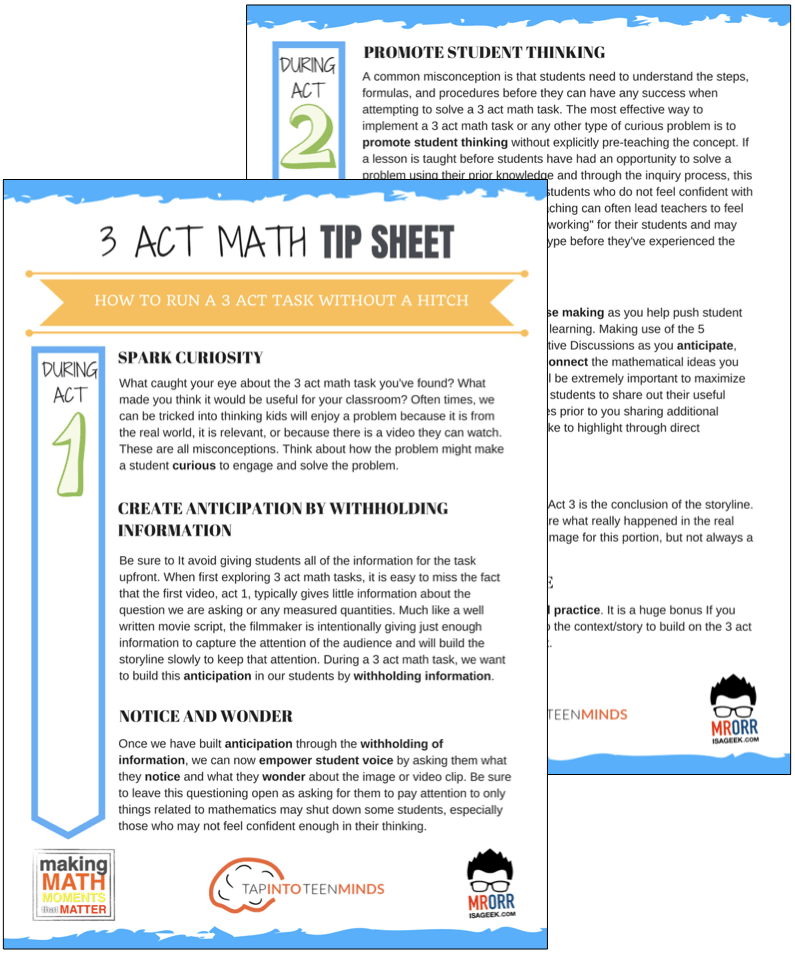
LESSONS TO MAKE MATH MOMENTS
Each lesson consists of:
Each Make Math Moments Problem Based Lesson consists of a Teacher Guide to lead you step-by-step through the planning process to ensure your lesson runs without a hitch!
Each Teacher Guide consists of:
- Intentionality of the lesson;
- A step-by-step walk through of each phase of the lesson;
- Visuals, animations, and videos unpacking big ideas, strategies, and models we intend to emerge during the lesson;
- Sample student approaches to assist in anticipating what your students might do;
- Resources and downloads including Keynote, Powerpoint, Media Files, and Teacher Guide printable PDF; and,
- Much more!
Each Make Math Moments Problem Based Lesson begins with a story, visual, video, or other method to Spark Curiosity through context.
Students will often Notice and Wonder before making an estimate to draw them in and invest in the problem.
After student voice has been heard and acknowledged, we will set students off on a Productive Struggle via a prompt related to the Spark context.
These prompts are given each lesson with the following conditions:
- No calculators are to be used; and,
- Students are to focus on how they can convince their math community that their solution is valid.
Students are left to engage in a productive struggle as the facilitator circulates to observe and engage in conversation as a means of assessing formatively.
The facilitator is instructed through the Teacher Guide on what specific strategies and models could be used to make connections and consolidate the learning from the lesson.
Often times, animations and walk through videos are provided in the Teacher Guide to assist with planning and delivering the consolidation.
A review image, video, or animation is provided as a conclusion to the task from the lesson.
While this might feel like a natural ending to the context students have been exploring, it is just the beginning as we look to leverage this context via extensions and additional lessons to dig deeper.
At the end of each lesson, consolidation prompts and/or extensions are crafted for students to purposefully practice and demonstrate their current understanding.
Facilitators are encouraged to collect these consolidation prompts as a means to engage in the assessment process and inform next moves for instruction.
In multi-day units of study, Math Talks are crafted to help build on the thinking from the previous day and build towards the next step in the developmental progression of the concept(s) we are exploring.
Each Math Talk is constructed as a string of related problems that build with intentionality to emerge specific big ideas, strategies, and mathematical models.
Make Math Moments Problem Based Lessons and Day 1 Teacher Guides are openly available for you to leverage and use with your students without becoming a Make Math Moments Academy Member.
Use our OPEN ACCESS multi-day problem based units!
Make Math Moments Problem Based Lessons and Day 1 Teacher Guides are openly available for you to leverage and use with your students without becoming a Make Math Moments Academy Member.
Partitive Division Resulting in a Fraction
Equivalence and Algebraic Substitution
Represent Categorical Data & Explore Mean
Downloadable resources including blackline masters, handouts, printable Tips Sheets, slide shows, and media files do require a Make Math Moments Academy Membership.
ONLINE WORKSHOP REGISTRATION
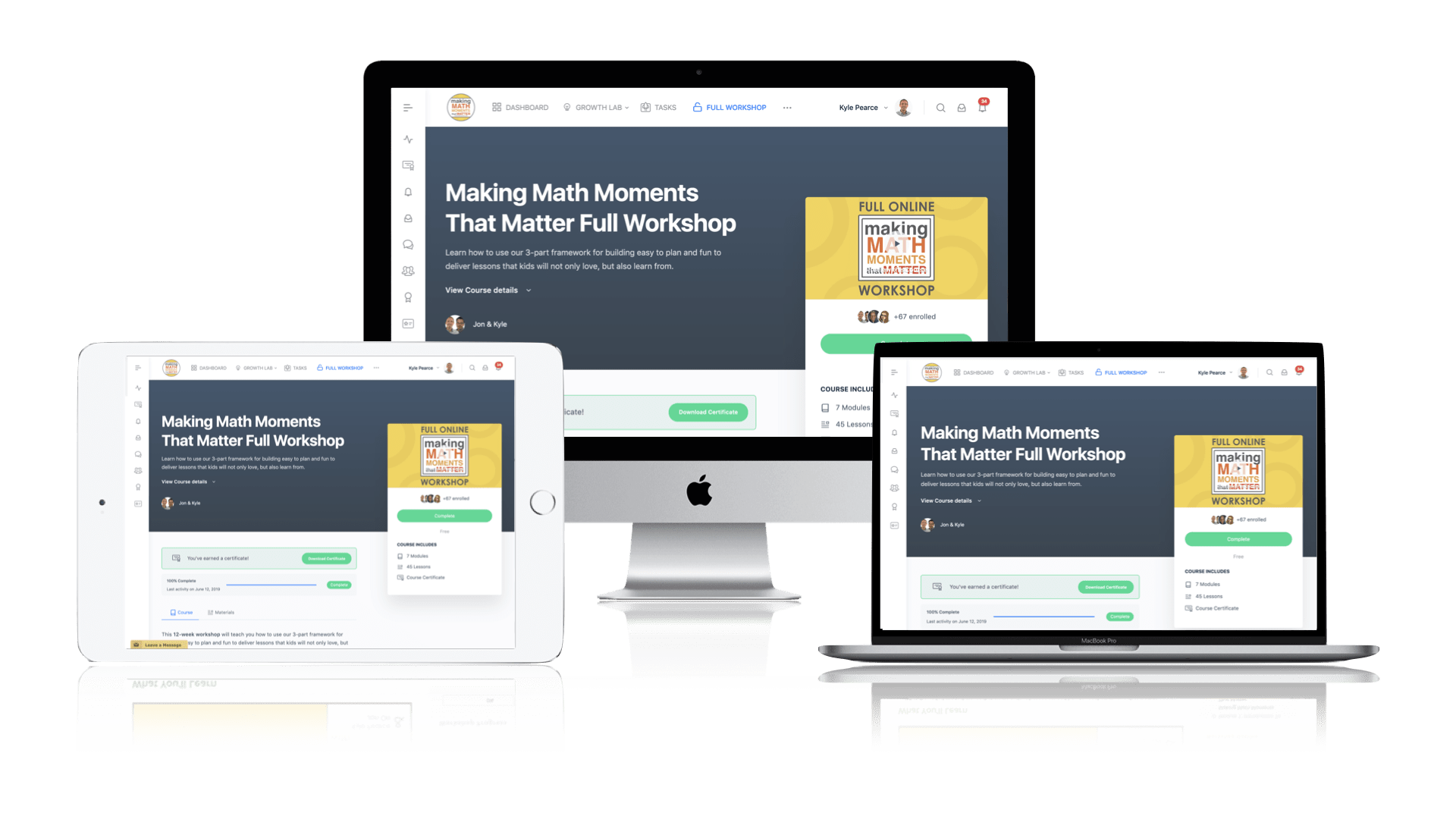
Pedagogically aligned for teachers of K through Grade 12 with content specific examples from Grades 3 through Grade 10.
In our self-paced, 12-week Online Workshop, you'll learn how to craft new and transform your current lessons to Spark Curiosity, Fuel Sense Making, and Ignite Your Teacher Moves to promote resilient problem solvers.
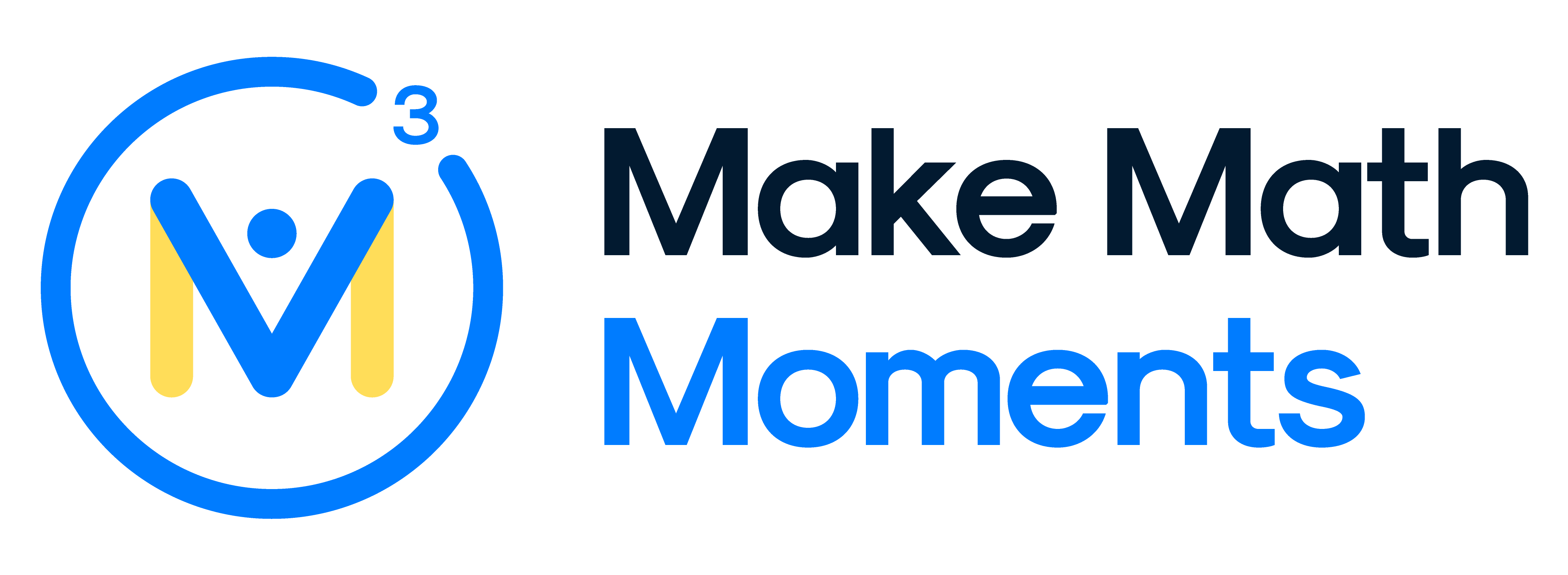



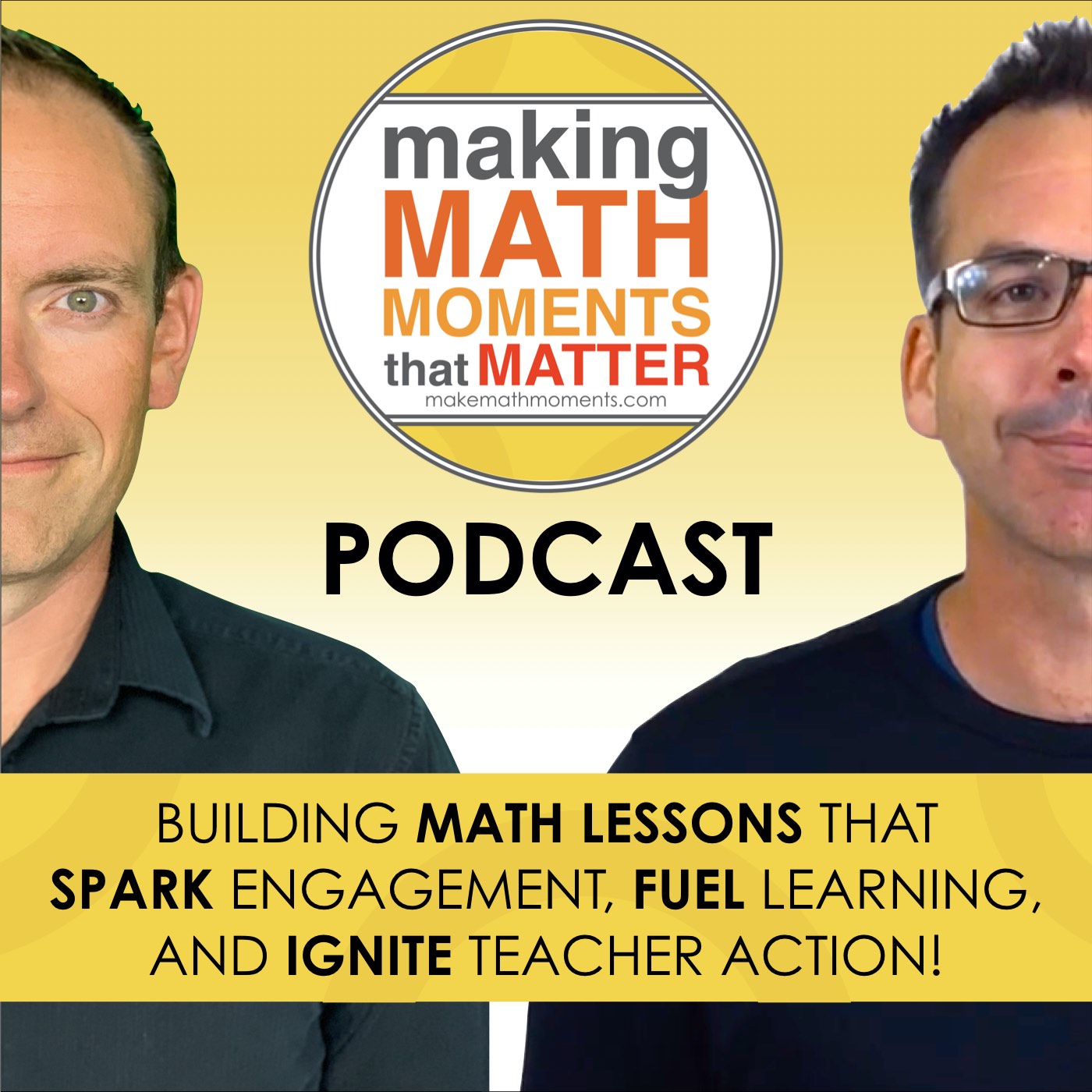
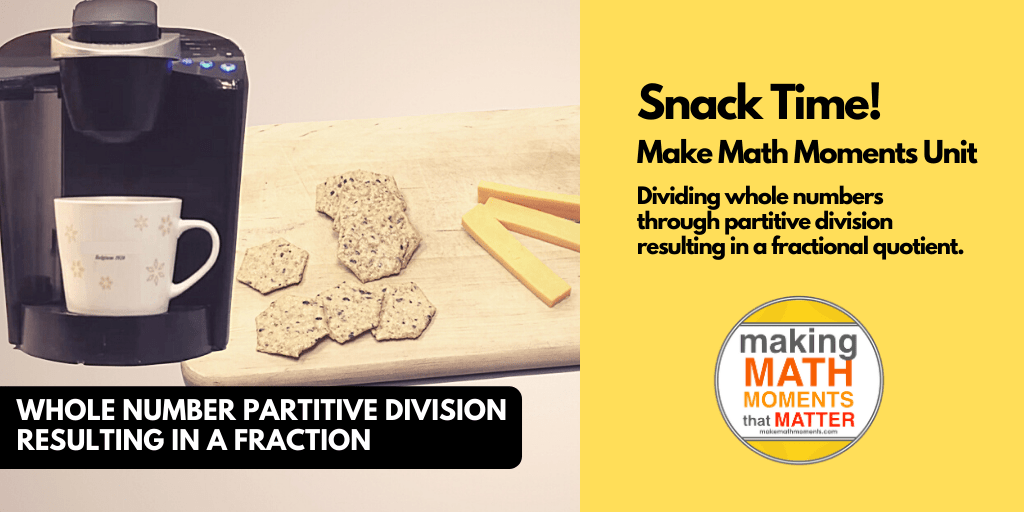

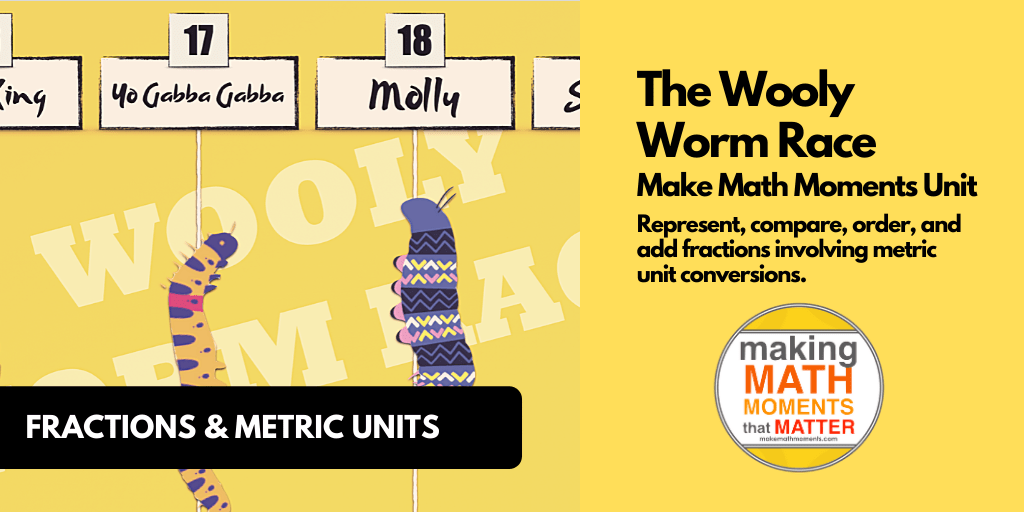
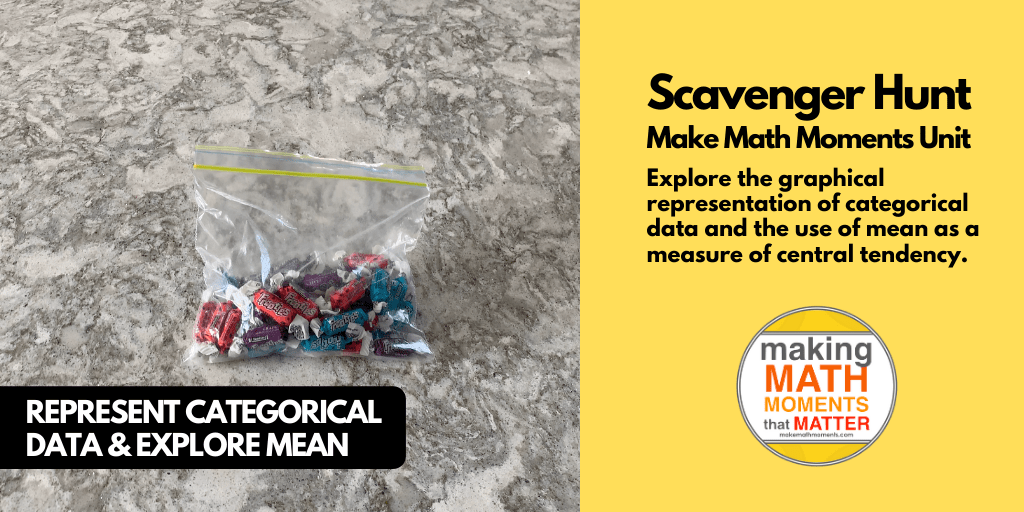
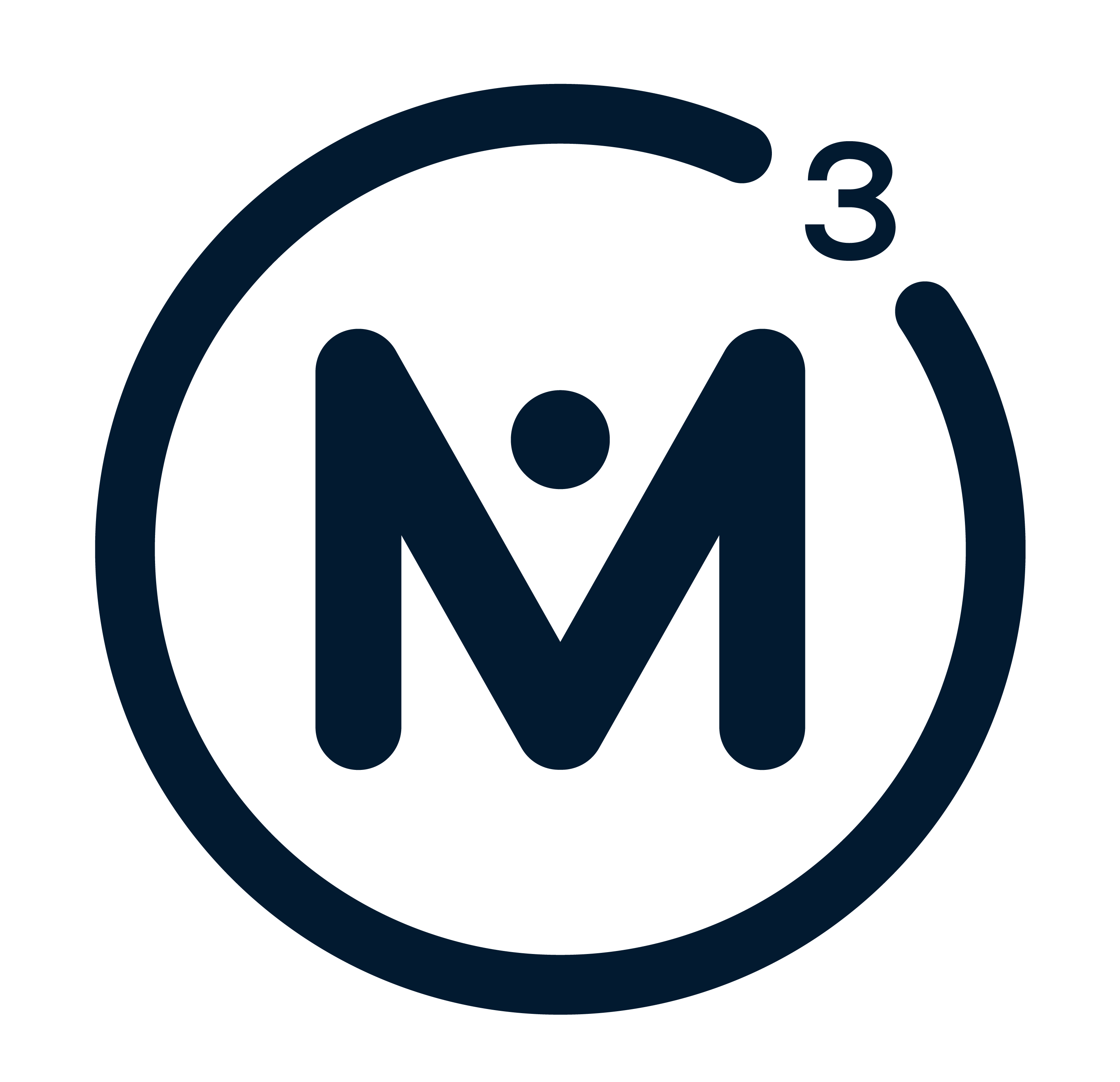
0 Comments